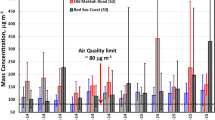Abstract
The atmospheric particulate of industrialized cities had become a mixture of potentially toxic substances whose concentrations must be monitored to assess the pollution levels. Trace metals and elements are part of these pollutants and the knowledge of their total concentration in the air as well as their distribution in the different aerosol particle sizes is necessary to evaluate the pollution risk in terms of maximum present levels and long term exposure. In the present work, a preliminary part of a study initiated for monitoring the trace element levels present in the atmospheric particulate of the city of Milan (north Italy) and of its suburban areas is presented. More than 25 elements have been determined in Milan downtown along a period of three years and in different weather conditions. The granulometric distribution of selected potentially toxic elements (such as vanadium, lead, cadmium, nickel) has been also determined to evaluate their concentrations in different inhalable fractions (alveolar and bronchial — tracheal). Instrumental Neutron Activation Analysis (INAA) has been used for the determination of the great part of the elements while Graphite Furnace Atomic Absorption Spectroscopy (GF-AAS) has been employed for the determination of lead and, in some cases, for nickel, cadmium and copper.
Similar content being viewed by others
References
W. Schroeder, M. Dobson, D. M. Kane, N. D. Johnson, J. Air Poll. Control Ass., (JAPCA), 37 (1987) 1267.
K. R. Spurny (Ed.), Physical and Chemical Characterization of Individual Airborne Particles, Ellis Horwood, Chichester, U.K., 1986.
R. Dams, Pure Appl. Chem., 64 (1992) 991.
A. Alian, B. Sansoni, Activation Analysis in Air Particulate Matter, in: Activation Analysis,Z. B. Alfassi (Ed.), 1990, 503.
W. D. Ehman, D. W. Vance, Radiochemistry and Nuclear Methods of Analysis, John Wiley, New York, 1991.
L. Schutz, K. A. Rahn, Environ., 16 (1982) 171.
S. R. Biegalsky, S. Landsberger, J. Radioanal. Nucl. Chem., 192 (1995) 195.
M. Gallorini, Microchemical J., 51 (1995), 127.
V. Krivan, K. P. Egger, Fresenius Z. Anal. Chem., 325 (1986) 41.
W. H. Zoller, E. S. Gladney, R. A. Duce, Science, 183 (1974) 198.
Author information
Authors and Affiliations
Rights and permissions
About this article
Cite this article
Gallorini, M., Borroni, P.A., Bonardi, M. et al. Trace elements in the atmospheric particulate of Milan and suburban areas: A study carried out by INAA. J Radioanal Nucl Chem 235, 241–247 (1998). https://doi.org/10.1007/BF02385969
Received:
Issue Date:
DOI: https://doi.org/10.1007/BF02385969




